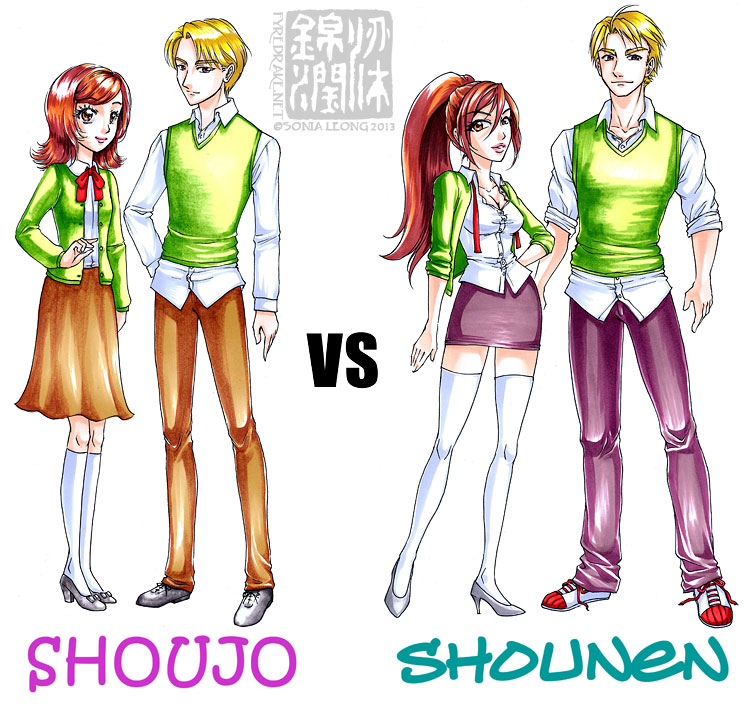Have you ever wondered why some anime and manga seem to be geared towards younger audiences while others feel like they’re speaking directly to adults? If your answer is yes, then you’ve stumbled upon the fascinating world of shonen and seinen – two distinct genres that dominate the anime and manga landscape. While both cater to the thrills of adventure, action, and romance, they do so with vastly different approaches and themes. Exploring this dichotomy unveils a captivating world of creative storytelling reflecting the experiences and aspirations of different generations.

Image: www.youtube.com
As you delve into the dynamic world of anime and manga, you’ll encounter the terms “shonen” and ” seinen” frequently. These labels don’t merely classify animation styles–they reflect targeted demographics and storytelling approaches. Shonen, roughly translating to “young boy,” primarily targets young male audiences, generally aged 12 to 18. Seinen, on the other hand, stands for “young man” and focuses on a more mature audience, typically adults – those aged 18 and above. Understanding the nuances of these genres allows you to appreciate the subtle yet powerful techniques that each employs to capture the intricacies of human experience.
The Roots of Shonen
Shonen stories often depict young protagonists embarking on journeys of self-discovery, pursuing their aspirations, or battling against overwhelming odds. They are vibrant and optimistic, focusing heavily on themes of friendship, teamwork, and overcoming challenges. This can be seen in classics like “Dragon Ball Z,” where Goku’s unwavering commitment to his friends and his relentless pursuit of strength drives the narrative. Shonen narratives typically emphasize the protagonist’s growth and perseverance; their struggles serve as inspiration for their younger audiences.
The origins of shonen can be traced back to the post-World War II era in Japan. As the country rebuilt, stories of resilience and overcoming adversity resonated deeply with its people, especially its youth. Shonen manga provided an outlet for escapism, offering tales of adventure and heroism that both entertained and inspired.
The Distinctive World of Seinen
Seinen stories tend to explore more mature themes: complex relationships, morally ambiguous characters, and the harsh realities of life. Examples include “Monster,” a psychological thriller that delves into the depths of human psychology, and “Vinland Saga,” a historical drama that portrays the brutality and complexities of warfare. Despite the darker subject matter, seinen still retains elements of action and adventure, albeit presented in a more nuanced and thought-provoking way.
The development of seinen manga emerged as a natural progression in the world of Japanese comics. As the youth who grew up on shonen matured, their interests evolved, demanding more complex narratives that resonated with their adult experiences. Seinen manga evolved to address these changing needs, showcasing the depth and diversity of mature storytelling.
Key Differences: A Closer Look
The differences between shonen and seinen extend beyond the age demographics they target. These genres often utilize distinct storytelling techniques and artistic styles to engage their respective audiences:
Theme and Plot:
- Shonen: Generally features lighthearted plots, optimistic characters, and emphasis on themes like friendship, determination, and overcoming challenges. They often center around action-packed sequences, exaggerated power scales, and fantastical settings.
- Seinen: Often explores more mature themes like social critique, political intrigue, emotional turmoil, and the complexities of human relationships. The narratives are typically more nuanced, sometimes emphasizing realism and exploring gritty, morally ambiguous characters.
Character Development:
- Shonen: Characters typically undergo linear development, growing stronger and more capable over time. They often exhibit unwavering optimism and are propelled by innate goodness, making their struggles particularly impactful for younger audiences.
- Seinen: Characters often struggle internally, grapple with challenging situations, and may not always take the “heroic” path. They are more complex and multifaceted, showcasing the complexities of human nature.
Art Style:
- Shonen: Frequently utilizes dynamic and energetic art styles, often characterized by exaggerated proportions and dramatic action scenes.
- Seinen: Art styles tend towards realism and subtlety, preferring to showcase character emotions and psychological complexities through facial expressions, posture, and environment. The overall aesthetic often leans towards somber or gritty, reflecting the mature themes explored.
Examples:
- Shonen: “One Piece,” “Naruto,” “My Hero Academia,” “Attack on Titan” (despite the darker themes, it’s considered shonen due to its target audience and focus on heroic characters)
- Seinen: “20th Century Boys,” “Fullmetal Alchemist: Brotherhood,” “Vagabond,” “Berserk”

Image: www.deviantart.com
The Power of Both Genres
While shonen and seinen cater to different demographics, both genres possess immense artistic power. Shonen’s ability to inspire and instill hope in younger audiences makes it a powerful tool for encouraging positive values and aspirations. Similarly, seinen’s exploration of mature themes and complex characters offers a platform for exploring the complexities of life, sparking critical thinking and deeper understanding of human nature.
Finding Your Own Narrative
Understanding the dynamics of shonen and seinen can help you navigate the vast anime and manga landscape, discovering stories that resonate with your own life experiences and interests. Whether you’re seeking a thrilling adventure with heroic protagonists or a thought-provoking exploration of human complexity, both genres provide a wealth of fantastic narratives.
Shounen Vs Seinen
Conclusion
The divide between shonen and seinen isn’t about being superior or inferior. Instead, think of it as a vibrant spectrum of storytelling, each catering to diverse audiences and offering unique perspectives on life, courage, and the human condition. Ultimately, the journey through anime and manga is a personal one. Explore both shonen and seinen, discover the narratives that resonate with you, and embark on adventures that will stay with you long after the final page is turned.





